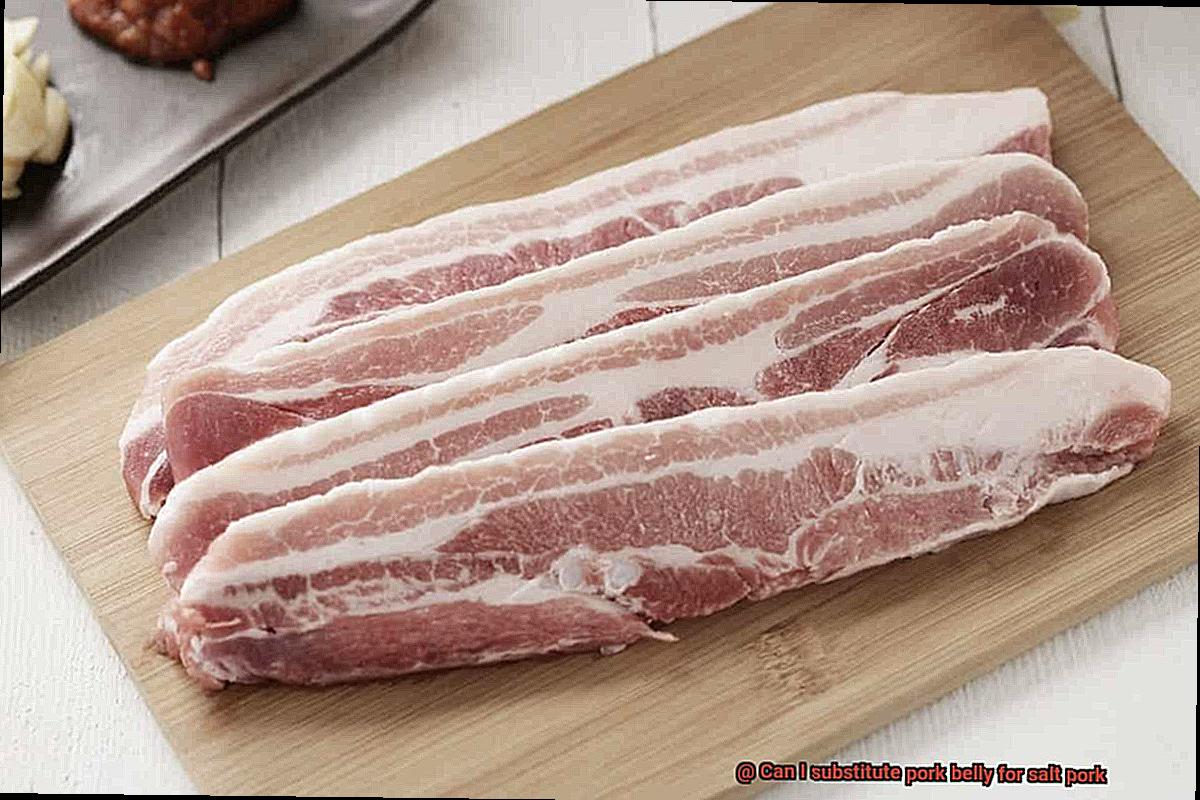Are you a pork aficionado? Do you ever get flummoxed when a recipe calls for salt pork and you don’t have any on hand? Don’t fret. There’s an alternative that might just knock your socks off – pork belly.
Juicy, fatty, and flavorful, pork belly is a sought-after cut of meat. It’s commonly smoked and cured to make bacon, but it can be prepared in various ways. Often overlooked as a substitute for salt pork, pork belly can hold its own in numerous recipes and withstand long cooking times without losing its texture or taste.
But can pork belly really replace salt pork? Salt pork is the cured fatback of the pig that imparts a rich smoky flavor to soups, stews, and other dishes. While not an exact match, pork belly can provide similar flavors and make an excellent stand-in for salt pork in many recipes.
In this blog post, we’ll delve into the differences between these two cuts of meat – their unique tastes and textures – and show you how to substitute one for the other properly. We’ll also share some mouth-watering recipes where you can use pork belly instead of salt pork. So whether you’re fresh out of salt pork or just curious about using pork belly in your cooking, keep reading to discover some new ways to elevate your favorite dishes.
Contents
What is Pork Belly?
The name alone may make your mouth water. But what exactly is it? Pork belly is a cut of meat that has become increasingly popular in recent years, and for good reason. This flavorful cut comes from the belly of a pig and is known for its tenderness, juiciness, and yes, its fat content. It’s no wonder pork belly is a favorite among food enthusiasts and chefs alike.

When you take a closer look at pork belly, you’ll notice its unique appearance – layers of meat and fat. The thickness of the fat layer can vary depending on the pig’s breed and diet, but most pork bellies strike a balance between the two. And when cooked properly, that fat layer renders down to create a perfectly crispy exterior that will have your taste buds dancing.
But let’s clear up any confusion – pork belly is not the same as salt pork. While both cuts come from the same area of the pig, they have distinct differences in their purpose and preparation. Salt pork is essentially cured pork belly that has been heavily salted and is often used as a flavoring agent in soups, stews, and other dishes. Its salty taste and different texture when cooked set it apart from pork belly.
If you’re considering substituting one for the other in a recipe, it’s important to understand these differences. Pork belly may not work as well in some recipes due to its high fat content, but it can be an excellent substitute in others. Just be sure to adjust your recipe accordingly based on the differences in salt content and texture.
What is Salt Pork?
Then it’s time to spice up your cooking with salt pork. As an expert on this topic, let me introduce you to the flavorful world of salt pork and how you can incorporate it into your cooking.
Salt pork is a type of preserved pork that has been cured in salt. This fatty cut of meat comes from the belly of the pig and is similar to bacon but is not smoked. The salt used in the curing process prevents spoilage and extends its shelf life, making it a staple ingredient in many cuisines around the world for centuries.
You can easily find salt pork at your local grocery store, usually located near other cured meats like bacon. It is often sold in small slabs or cubes, so you can easily cut it into smaller pieces as needed for your recipes.
It’s important to note that salt pork is incredibly salty and should be used sparingly in your cooking. However, when used correctly, it can add a depth of flavor that is unmatched by any other ingredient.
One classic use for salt pork is adding it to soups, stews, and beans. Its rich flavor can elevate these dishes to new heights, making them more satisfying and delicious. Another popular use is to dice it into small pieces and cook until crispy, creating lardons that make a perfect topping for salads or soups.
But remember, salt pork should be consumed in moderation due to its high sodium content. So go ahead and experiment with this versatile ingredient, but don’t overdo it.
Differences Between Pork Belly and Salt Pork
Pork belly and salt pork may share the same origin, but they are two different animals when it comes to cooking. As an expert in the culinary arts, let me take you on a flavorful journey through the differences between these two cuts of pork.
First, let’s talk fat. Pork belly is famously known for its high levels of fat, making it a popular choice for dishes like bacon or roasted pork belly. Meanwhile, salt pork is leaner due to its preservation process, which involves curing with salt. Therefore, if you’re looking for a healthier option or something that’s lower in fat, salt pork is the way to go.
Texture is another significant difference between these two cuts of meat. Pork belly is tender and juicy, while salt pork has a firmer texture. Since salt pork is cured, it can be quite salty, which not only affects its texture but also the overall flavor of a dish if used as a substitute for pork belly.
Now let’s dive into their culinary uses. Pork belly is a favorite in Asian cuisine and can be served as a standalone dish or used as an ingredient in stir-fries or soups. Some popular examples include Korean samgyupsal and Chinese red-braised pork belly. Salt pork, on the other hand, is typically used as a flavoring agent or seasoning in traditional American dishes such as baked beans or chowders.
In summary, while both cuts originate from the same part of the pig, they have distinct characteristics that make them suitable for various dishes. Remember to choose wisely when substituting one for the other in a recipe. Consider the dish’s texture and flavor requirements before making your decision.
Advantages of Substituting Pork Belly for Salt Pork
Firstly, pork belly boasts a richer, more complex flavor due to its higher fat content. The extra fat adds a depth of flavor that salt pork cannot match. Additionally, the meat from pork belly is more tender and juicy, making it perfect for grilling or adding to soups and stews.
Another advantage of using pork belly is its availability. While salt pork can be challenging to find in some areas, pork belly is readily available in most grocery stores and markets. This accessibility means that you can quickly substitute pork belly for salt pork without having to search extensively.
But the real advantage of using pork belly over salt pork is its versatility. Salt pork is mainly used for adding saltiness to dishes, while pork belly can be used in a variety of recipes beyond that. From stir-fries to pizzas, the possibilities are endless. This versatility makes it a great option if you’re looking to experiment with different flavors and recipes.
Lastly, substituting pork belly for salt pork can be a healthier option. Salt pork is high in sodium, which can lead to health problems if consumed in excess. Pork belly also contains sodium but not as much as salt pork. Additionally, the fat content in pork belly is primarily unsaturated fat, which is considered healthier than the saturated fat found in salt pork.
Disadvantages of Substituting Pork Belly for Salt Pork

While pork belly is a tasty and versatile ingredient, there are some disadvantages to using it as a replacement for salt pork that you need to consider.
Firstly, the texture of pork belly differs greatly from that of salt pork. Salt pork is firm and lean, while pork belly is softer and fattier. This difference can significantly impact the overall flavor and texture of your dish. The firmer texture of salt pork adds a unique chewiness to soups, stews, and beans that cannot be replicated with the softness of pork belly.
Another potential issue with substituting pork belly is the difference in salt content. Salt pork is heavily salted, which infuses a distinct flavor into dishes. In contrast, pork belly has a lower salt content and may require additional seasoning to achieve the desired taste.
Cooking time and method are crucial factors to consider when using pork belly as a substitute for salt pork. Its higher fat content means that it may take longer to cook, which can result in undercooked or overcooked dishes if not carefully monitored. In contrast, salt pork’s leaner texture cooks more quickly, ensuring that dishes are cooked evenly.
Aside from these factors, it’s worth noting that pork belly is typically more expensive than salt pork. While it may be worth the investment if you’re looking to elevate the flavor of a particular dish, it may not be practical for every recipe.
Tips for Substituting Pork Belly for Salt Pork
Substituting pork belly for salt pork can be a great way to switch up the flavors in your favorite recipes, but it’s important to keep in mind the differences between the two cuts of meat. Here are five tips to help you successfully substitute pork belly for salt pork.
Understand the Differences Between Pork Belly and Salt Pork
Pork belly and salt pork may come from the same area of the pig, but they are two very different cuts of meat. Pork belly is a fatty cut of meat that is often used in dishes such as bacon, barbecue, and Asian cuisine. Salt pork, on the other hand, is made from the fatty layer of pork belly that has been heavily salted and cured. Knowing these differences can help you make better adjustments to your recipe.
Adjust the Salt Content
One of the biggest differences between pork belly and salt pork is their level of saltiness. Salt pork is heavily salted and cured, while pork belly may not have as much salt content. To ensure that your dish has the right balance of flavors, you may need to adjust the amount of salt that you add when using pork belly as a substitute for salt pork. Start with a smaller amount of salt and adjust as needed based on taste.
Consider the Fatty Content
Pork belly is a very fatty cut of meat, which can be a good thing in some recipes but may not work as well in others. If you’re using pork belly as a substitute for salt pork, take into account the extra fat content and adjust your cooking times and temperatures accordingly. You may also want to trim off some of the excess fat before cooking.
Adjust Your Cooking Times and Preparation Methods
Since pork belly is a thicker cut of meat than salt pork, it may require longer cooking times or different preparation methods. For example, if you’re using pork belly in a soup or stew recipe that calls for salt pork, you may want to cut it into smaller pieces to ensure that it cooks evenly and becomes tender. You could also try searing the pork belly before adding it to the dish for extra flavor.
Stick to the Original Recipe When Necessary
While pork belly can be used as a substitute for salt pork in many recipes, there are some dishes where the two cuts simply won’t work interchangeably. For example, if you’re making traditional New England-style baked beans, salt pork is an essential ingredient and cannot be substituted with pork belly. In cases like these, it’s best to stick with the original recipe or seek out a more suitable alternative.
Recipes that Work Well with a Substitution of Pork Belly for Salt Pork
Then substituting pork belly for salt pork might just be the answer you’ve been looking for. Pork belly is a versatile cut of meat that can be used in a variety of dishes, adding a rich and delicious flavor to any meal.
Here are five incredible recipes that work well with a substitution of pork belly for salt pork:
- Bean Soup – This classic comfort food dish can be made even better with the addition of pork belly. The fatty richness of the meat adds depth of flavor and enhances the overall taste of the soup. Plus, it’s a perfect dish for cool weather.
- Fried Rice – Fried rice is one of those dishes that’s quick, easy, and always customizable. Substitute pork belly for salt pork to add a rich flavor and tender texture to the dish. You can also dice the pork belly into small pieces and fry until crispy for an extra crunch.
- Stir-Fry – When you need a quick and easy meal, stir-fry dishes are always a great option. Pork belly is an excellent substitute for salt pork because its rich flavor pairs well with vegetables and sauces, making it an ideal protein source for any stir-fry recipe.
- Tacos – Tacos are a beloved dish around the world, and substituting pork belly for salt pork is an excellent way to switch things up. Roast or grill the pork belly and then dice it into small pieces to make a delicious filling that will make your tacos stand out. Its rich flavor pairs well with traditional taco seasonings like cumin, chili powder, and paprika.
- Carbonara – Carbonara is a classic Italian pasta dish that typically calls for pancetta or bacon, but substituting pork belly can take this dish to the next level. Its rich flavor enhances the creamy sauce, making it a decadent and delicious meal you won’t forget.
Alternatives to Subsituting Pork Belly for Salt pork
Fear not, there are plenty of alternatives that can be used in its place without sacrificing taste or texture.
One popular option is bacon, which is made from pork belly and boasts a similar flavor profile as salt pork. However, it’s essential to note that some brands of bacon may contain added ingredients such as sugar, so be sure to read the label before using it as a substitute.
For those looking for a more delicate taste and texture, pancetta is an excellent choice. This Italian cured meat is also made from pork belly but has a slightly different flavor than salt pork. It’s also typically less salty, making it ideal for those watching their sodium intake.
If neither bacon nor pancetta are available, other types of cured meats can be used in their place. Prosciutto or serrano ham both have a similar flavor profile to salt pork and are suitable substitutions in many recipes.
However, if you prefer to avoid cured meats altogether, don’t worry. You can always omit the salt pork and adjust the seasoning of the dish accordingly. Adding additional herbs and spices can help enhance the overall flavor without sacrificing taste or texture.
It’s essential to remember that each substitute will have its own unique taste and texture that may affect the outcome of the dish. Don’t be afraid to experiment with different options until you find the perfect substitute for your needs.
In summary, here are some excellent alternatives to substituting pork belly for salt pork:
DtoyPherfbI” >
Conclusion
In conclusion, pork belly can be a versatile substitute for salt pork in various recipes. However, it’s crucial to understand the differences between these two cuts of meat before making any substitutions. While both originate from the same part of the pig, they have distinct characteristics that make them suitable for different dishes.
Pork belly is a luscious and flavorful cut that can add depth and complexity to soups, stews, stir-fries, and more. Its high fat content makes it ideal for slow-cooking methods like braising or roasting. On the other hand, salt pork is leaner due to its preservation process and has a salty, smoky flavor that can enhance dishes like beans or chowders.
When substituting pork belly for salt pork, it’s critical to adjust seasoning and cooking times accordingly. You may also want to consider other alternatives such as bacon, pancetta, prosciutto or serrano ham depending on your dietary requirements and preferences.
In summary, don’t be afraid to experiment with different substitutes in your cooking. It may lead you to discover new flavors and textures in your favorite recipes. Whether you’re looking for a healthier option or simply want to switch things up in the kitchen, there are plenty of options available to suit your needs.






